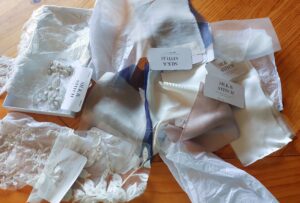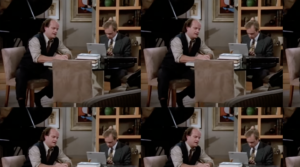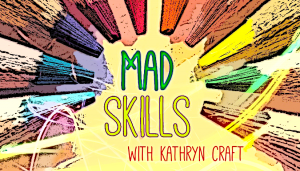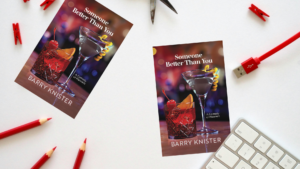Process
When it comes to creating a believable setting or background for a work of fiction, sensory inspirations are very important. Writers need to evoke a world in the reader’s mind which doesn’t just involve the visual and the auditory, but also hopefully bring the other senses into play—touch, smell, taste. It’s always been important to me, as I’m sure it is for many other writers, to experience the atmosphere of places I’m evoking through my stories: I like to actually walk in their streets, to see small details, to hear the soundscapes, whether that be birds, sirens, music, machines, to listen to the tone of voices. I like to experience the smells—good or bad, strong or faint—of those places, and their tactile textures, and the taste of the food you might find there. The sensory impressions you gain from all of it are invaluable. Even if a place is imaginary, I always base it on real locations, so the sensory aspects still ring true. And that means also being able to call up those impressions even when you are back home, and not just through your memory, but through aids such as notes, photos, and video and audio clips.
That works well for the visual and auditory aspects. But what about the other senses—touch, smell, taste? Their effect cannot be fully recaptured through photos, notes, or video/audio. More ephemeral than the visual or the auditory, those three senses are nevertheless crucial to evoking atmosphere: think for example of Proust’s famous madeleines. And it’s not just about place—it’s also about many other elements in a story that will make your fictional world feel absolutely real in a reader’s mind. How, for example, to describe the taste of a dish, if you haven’t tried it? How can you evoke the scent of a particular perfume, if you’ve never smelled it? Or the feel of a particular fabric, if you’ve never touched it?
For me, the answer is to collect concrete objects that bring my story-brain into direct hands-on contact with the sensory experience itself. Over the years I’ve done a lot of that. For example, for a novel I’ve been working on, I needed to understand how different types of silk fabric and lace embellishments might interact with each other and be used in design. I didn’t just rely on my imagination, my lived knowledge of how silk feels against the skin and my observation of a seamstress at work. I also purchased a range of fabric and lace samples which would enable me to see and feel first-hand just how a particular design might work with types of silk fabric. For the same novel, where there is a small but significant mention of the perfume Joy, I didn’t just rely on my memory of my beautiful grandmother’s favourite scent, I managed to find a miniature bottle of the vintage fragrance online, so I could experience the full power of it, and be able to describe it properly. Similarly, in another novel, recently published, where I wrote about the look, smell and feel of various flowers, I needed to actually have some on hand so I could accurately evoke them. In yet another novel, which is centred around food, I didn’t just cook several […]
Read MoreThe other day, while sharing pages with my critique group, I had a scene where a character finds a camera loaded with film in her dead friend’s apartment. The response from my crit partners: “Oooh, I can’t wait to find out what’s on there when she gets it developed.” My response? “Yeah, me too!” I’m only about 15,000 words in and who knows what happens next—I certainly don’t.
Clearly, I’m not a plotter. There’s a lot of talk about writers being either pantsers (writing by the seat of your pants) or plotters (scenes are laid out with white boards, index cards, or plotting programs before a single word is written). But I came across a term the other day that I prefer. I’m a “discovery writer.” Maybe you’re already familiar with the term, but it was new to me, and I felt truly seen.
After deciding to write this essay, I attended the Texas Book Festival in Austin, TX, where I live, and I had the pleasure of listening to Jean Hanff Korelitz, author of The Plot and The Sequel among others. When she was asked about her writing process, she said she doesn’t plot or outline. She discovers as she’s writing. I wanted to run up to the stage, give her a high five, and hug her.
I never liked outlining, even as a kid in school. All those Roman numerals, numbers, capital letters, lower case letters made my head spin, leaving me confused and frustrated. Not much has changed. When I write, I have an idea of how I want the story to start and how I want it to end, but that’s pretty much it. The rest I “discover” as I write. I’m the first to admit that it’s the least efficient method of storytelling. Sometimes I “discover” when I go back and reread what I’ve written, that I’ve taken the story in the wrong direction. It doesn’t jibe with what came before. So, time and effort and brain drain are involved in getting things back on track. Some might say that’s the masochistic method of writing. Maybe they’re right. But it’s out of my control.
I tried to be a plotter. I really did, or at the very least, a “plantser,” where I outline at least some of the scenes in my story. I bought index cards, a corkboard, and push pins. When that didn’t get me where I wanted to go, I bought a white board and markers. When that failed to produce a well thought out story, I tried the inside outline that so many writers and editors point to as the key to success. I think I’m allergic. My brain literally rebels and I feel like I’m breaking out in hives when I’m asked to look behind the curtain when I’m not even sure what play I’m watching. I’ve read Lisa Cron’s “Wired for Story,” Blake Snyder’s “Save the Cat,” and Donald Maass’ “Writing the Breakout Novel.” I’ve watched countless videos and attended virtual workshops. Nothing works. I’m that square peg trying to force myself into a round hole. It’s never going to fit, no matter how hard I try. And no matter how much other writers and editors proselytize the virtues of outlining and try to bring […]
Read MoreGreetings, WU Family. In my first post of the year, I’m introducing you to Ann Michelle Harris. Ann Michelle is an attorney by day, and at night, she writes romantic suspense and fantasy/speculative fiction with diverse characters and positive social justice themes. In today’s Q&A, she shares how her work in the areas of poverty, abuse, and child welfare guides her, how that work inspired her novel, North, and why she feels building community is one of the most important things a writer can do for their career.
GW: One of my favorite parts of this series is learning about an author’s origin story: the thing that propelled you from someone who only thought about writing to someone who actually wrote and has a book out. So, what’s your author origin story—in other words, why did you start writing and keep writing?
AMH: I have loved reading adventure stories since I was very young. I was an English major at Penn so I loved not just stories but also story analysis, themes, and structure. Several years ago, I went through a stressful time in my life and began immersing myself in escapist stories as a form of comfort. After months of consuming other people’s stories, I decided to become a contributor of short stories to a public writing forum. Positive responses convinced me that I might have a larger story worth telling and that I could be brave enough to take the risk to try to tell it. I specifically wanted to write an adventure story in honor of my children. Shortly after this, the pandemic came and gave me even more stress but also much more time to write since I no longer had to spend hours commuting to the office each day (and it gave me plot inspiration). That extra time allowed me to dig deeper into creating a full manuscript and begin the process of querying.
GW: Can you tell us about your path to getting North published?
AMH: After completing my manuscript, I began to query it to a few agents and independent publishing houses. I got rejections, but one rejection from a large indie press had detailed feedback about the plot (particularly the ending) and that helped me tweak some elements. I also worked with a developmental editor, a beta reader, and a critique group to fine-tune the scene structure and build more tension in the story arc. By then, I had heard from a few writers that it is sometimes more accessible to directly find a publisher than to find an agent. I had another historical gothic manuscript that was getting a lot of traction with agents, but I decided to pitch North to a small press at a writing conference, and they loved it after reading the full story. After I signed the publishing contract, I continued to fine-tune the manuscript and then worked with the publisher for editing, galleys, and cover design. I tweaked everything until it was ready for submission to the distributor, and then finally it went into pre-order. I used my pre-launch time to promote the book online, connect with readers, and lean heavily on the wisdom of my more experienced writer colleagues, who were incredibly supportive. Then the big day came […]
Read MoreAs the years go by, the average age of debut authors seems to get younger and younger. There’s plenty of reasons why this is great: the YA genre embracing authors who are the ages of their characters, the removal of societal assumptions that younger people can’t contribute to art in a meaningful way, the increase in opportunities for younger writers to access helpful resources, etc.
Conversation about this reality would stop there if two things didn’t start to emerge from this trend: 1) the publishing industry skewing notably toward younger writers to the point of sometimes completely shutting out older writers (meaning older than—gasp—30, 35 tops) for consideration for agent representation, publication, awards, or reviews, and 2) the assumption that the younger a writer publishes, the more “naturally gifted” of a writer they must be, and therefore a better writer than those who debut older.
I’ve taught plenty of creative writing courses, and nearly all my older students have expressed an identical concern: That because they’re older, they’ll be largely ignored by the industry both pre- and post-offer. Worries about age have even hit some of my younger students. On their end, they’ve been fed the assumption that since younger equals better, they must land a book deal right out of the gate. If they don’t, they’re failures, will soon be “too old” to publish in a way deemed meaningful, and they should just give up if their path to publication isn’t a breeze from beginning to end.
That’s just not how any of this works. As someone who’s publishing his debut, The Lilac People, at an apparently older age—To paraphrase a petulant Frasier Crane: I’m not yet “of a certain age,” I’m smack dab in the middle of “not a kid anymore.”—and spent over a decade collecting rejections from various projects, I want to set the record straight about the benefits of publishing older.
Read MoreThe violent metaphor of writers killing their darlings has never appealed to me. I understand that we sometimes need to disrupt the comfort of our revision process, but may I suggest something a little less murderous? Tasty, even?
One of the treasured picture books of my childhood was Stone Soup. Have you read it? In this retelling of an old European fable, a hungry traveler approaches a village known for its miserly inhabitants. Desperate for food, he concocts a trick to get them to feed him. He sets up a large cauldron in the middle of the town square and fills it with water, then places a stone in the bottom of the cauldron. As it heats up, a villager comes to ask him what he’s doing.
“I’m making stone soup,” he replies, stirring the water and occasionally taking a sip. “It’s coming along nicely, but it would taste better with salt.”
The curious villager runs home and brings back some salt. By now, a crowd has gathered. The traveler seasons his soup with salt, takes another sip, and sighs. “An onion or two would be just the thing,” he says. A second villager brings an onion.
On and on it goes, with the additions of carrots, potatoes, and whatever else would go into a hearty stew. At the end, he fishes out his stone and shares a delicious meal with the no-longer hostile and selfish village. Together they’ve created stone soup.
This story delighted me on multiple levels. I loved the ingenuity of the newcomer, the gradual and piecemeal thawing of the villagers, the delicious soup that fed them all. I loved the chutzpah of fooling an entire town into thinking that a stone chucked into some boiling water could become something worth consuming.
As an adult, I still delight in the story of stone soup, but now I read it as a good metaphor for writing (isn’t everything?).
Your brain picks up a shiny bauble of an idea. It might be an interesting character, a fabulous setting, or a devilishly twisty plot. If a story in its most simplified form is simply a person, in a place, with a problem, then any of those three elements could be the stone tossed into the cauldron of your imagination.
The water comes to a boil as you go about your daily life. Soon, if your mind is at all like mine, your subconscious starts to sniff around. What’s cooking? Is it any good?
The nay-saying villagers who have colonized my mind, at least, can be a pretty suspicious bunch. They tell me that a rich and hearty story will never result from that bare rock sitting at the bottom of my pot—but they can be tricked into sharing the observations that are hidden inside the cupboards of my memory.
With a little persuasion, they open the cabinets and rummage around. Ideas, snatches of conversation, resonances from other books, and intriguing people I’ve met all add ingredients to the mix:
That guy with a scar that I saw at the bus stop? He’d make a perfect salty foil.
That snatch of conversation I overheard in the coffee shop? Unexpected zest.
That book I just finished reading, the one that tells its story in layers like an onion? I might slice it […]
Read MoreWhile I have earned nothing beyond a BA in English, I’ve never let that stop me from pretending I have a vast array of training and advanced degrees at my fingertips. Need a marriage therapist who’s willing to work for free? I’m your gal. Looking for a pro bono private investigator? You’ve come to the right place! Hoping to stumble upon a psychiatrist who specializes in diagnosing those who don’t know they need a diagnosis? Yep, I can do that too.
On December 24th, I found myself at Safeway, picking up the items I had forgotten to purchase on the grocery runs I had made on the 22nd and 23rd. Safeway is my go-to because I grew up shopping at Safeway. And I am a cheapskate. It’s also a little gritty, which I appreciate, because at the chichi grocery store that’s a little closer to my house, the apples are too beautiful, the specialty items too special, the shoppers too coiffed. At Safeway? I feel perfectly at home log-rolling myself from bed to car to Safeway. No coiffing required.
It was in the produce section that I found myself picking green beans from a heap and standing about fifteen feet from a couple near the potatoes. I noticed them because they appeared both too coiffed to be shopping at Safeway and too calm to be shopping on Christmas Eve. But there was something else about them that piqued my interest.
Summoning everything I learned while earning my pretend PhD in Psychology, I began my initial assessment of the couple. I guessed they were in their early 40s. She had a sassy blonde bob and wore denim trousers and a Santa hat. He was well-dressed and conventionally handsome; if you Google “generic handsome man,” you will see many iterations of him. They each wore a ring on their wedding finger. Mr. Handsome was pushing the cart.
They looked nice enough, but something was vaguely rotten in this aisle of Safeway.
Knowing I needed to move physically closer to the couple, I called on the acting skills I had learned during my pretend years at Julliard. Pretending to be checking my grocery list, then pretending I had ALMOST forgotten the onions, I pushed my cart over to the onion section. Sometimes you pretend you need a Walla Walla sweet, even if you already have onions at home, so you can eavesdrop on a couple in the nearby potato section.
And eavesdrop I did! I listened as the couple spoke of their butter lettuce options as if butter lettuce could make or break Christmas. They discussed the gift card they had purchased for his parents (at the fancy Italian restaurant down the street) and the gift card they would buy for her parents (at the fancy bakery up the street). They discussed stocking stuffers for their kids, the wrapping of gifts they needed to do that evening, the bourbon they wanted to get at the fancy liquor store. All this, while I committed, acting-wise, to finding the most perfect onion I didn’t even need.
It wasn’t the content of their conversation that felt off; it was their tentative, cautious tone and […]
Read MoreToday’s “ad post” is also a valuable blog post written by our own Barry Knister, detailing his experience with two editors while preparing his novel, Someone Better Than You, for publication. Enjoy!
Deciding to work with an editor is a major decision. It costs money, and calls on the writer to do something analogous to what all good parents must do: love their children enough to let them go (at least until they come home and move into the basement).
That’s what the writer does when she turns over her baby to an editor. This person will get to know the fledging novel or memoir, but usually with no knowledge of how it came to be. That means, when the baby comes home, the writer must will herself into a kind of amnesia, in order to absorb and respond to the stranger’s reactions.
That’s why I urge writers to read a report, but to then put it aside for a week or more before going back to it. Otherwise, they risk acting or reacting on impulse.
Recently, I worked with two editors on my forthcoming novel, Someone Better Than You. By coincidence, both people are past editors for Penguin. In every respect, working with these editors led to improvements in my novel. I acted on most but not all of their suggestions, and what follows is my attempt to summarize the process.
RONIT WAGMAN
I first hired Ronit in 2020 to read and report on the full manuscript of what was then titled Ashley and the Jell-O Hour. Although she liked the story (“the world of the novel and the characters that dwelled in it felt deeply authentic to me”), she had several major criticisms.
AGENCY
In the version Ronit read, my main character Brady “Buzz” Ritz is a retired newspaper editor. His life is upended when he publishes a book of his anonymously published satirical columns. He blunders mightily by publishing the book’s second edition under his own name.
In this first version, Brady’s book comes about through the actions of others. The editor of Grumble (the little magazine that first published his column) talks Brady into developing a book of his work. Ritz’s best friend from his newspaper days gets an agent friend to find a publisher. Most importantly, the best friend shames Ritz into using his own name for the second edition.
As Ronit explained, I had made my main character the passive pawn of others. Someone else pushes him to develop the book, and someone else arranges for it to be published. Most importantly, someone else is responsible for Ritz publishing the second edition under his own name.
Ronit’s guidance led me to make Ritz less a passive actor, and more the responsible agent for his story. He still gets the idea for the book from his editor, but as Ronit pointed out, no agent would take on such a manuscript from an “anonymous” writer—because no publisher would be interested in such a book.
So, I replaced a commercial publisher with a university press whose editor has the freedom to publish something by an unknown writer. I also got rid of the idea of a second edition. Once I made these changes, I was free to make Brady responsible for the […]
Read More





















